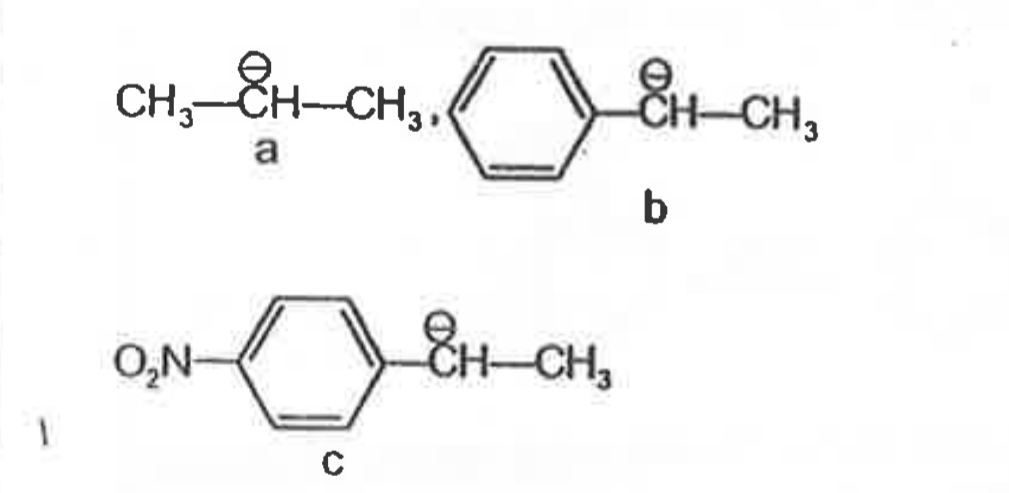Correct stability order of the given free radicals is




The correct Answer is:B
To determine the correct stability order of the given free radicals, we need to analyze the stability of each radical based on the effects of resonance, inductive effects, and hyperconjugation. Here’s a step-by-step breakdown of the solution:
Step 1: Identify the Free Radicals
The free radicals in question are:
1. Benzyl radical (C6H5-CH2•)
2. Tertiary radical (R3C•, where R = CH3)
3. Secondary radical (R2CH•, where R = CH3)
4. Methyl radical (CH3•)
Step 2: Analyze the Stability Factors
1. Benzyl Radical:
- The benzyl radical can stabilize through resonance. The unpaired electron can be delocalized over the aromatic ring, which significantly increases its stability.
- Stability: High due to resonance.
2. Tertiary Radical:
- The tertiary radical is stabilized by both hyperconjugation and the inductive effect from the three surrounding alkyl groups (methyl groups).
- Stability: Moderate to high due to hyperconjugation and inductive effects.
3. Secondary Radical:
- The secondary radical is also stabilized by hyperconjugation and inductive effects, but to a lesser extent than the tertiary radical since it has only two alkyl groups.
- Stability: Moderate.
4. Methyl Radical:
- The methyl radical has no alkyl groups to stabilize it through hyperconjugation or inductive effects. It is the least stable of the radicals.
- Stability: Low.
Step 3: Establish the Stability Order
Based on the analysis:
- The benzyl radical is the most stable due to resonance.
- The tertiary radical is next due to hyperconjugation and inductive effects.
- The secondary radical follows.
- The methyl radical is the least stable.
Final Stability Order
The correct stability order of the given free radicals is:
Benzyl radical > Tertiary radical > Secondary radical > Methyl radical
The free radicals in question are:
1. Benzyl radical (C6H5-CH2•)
2. Tertiary radical (R3C•, where R = CH3)
3. Secondary radical (R2CH•, where R = CH3)
4. Methyl radical (CH3•)
1. Benzyl Radical:
- The benzyl radical can stabilize through resonance. The unpaired electron can be delocalized over the aromatic ring, which significantly increases its stability.
- Stability: High due to resonance.
- The tertiary radical is stabilized by both hyperconjugation and the inductive effect from the three surrounding alkyl groups (methyl groups).
- Stability: Moderate to high due to hyperconjugation and inductive effects.
- The secondary radical is also stabilized by hyperconjugation and inductive effects, but to a lesser extent than the tertiary radical since it has only two alkyl groups.
- Stability: Moderate.
- The methyl radical has no alkyl groups to stabilize it through hyperconjugation or inductive effects. It is the least stable of the radicals.
- Stability: Low.
Based on the analysis:
- The benzyl radical is the most stable due to resonance.
- The tertiary radical is next due to hyperconjugation and inductive effects.
- The secondary radical follows.
- The methyl radical is the least stable.
The correct stability order of the given free radicals is:
Benzyl radical > Tertiary radical > Secondary radical > Methyl radical
Topper's Solved these Questions
- BOOK - AAKASH INSTITUTECHAPTER - ORGANIC CHEMISTRY: SOME BASIC PRINCIPLE AND TECHNIQUESEXERCISE - SECTION-C OBJECTIVE TYPE QUESTION (MORE THAN ONE OPTIONS ARE CORRECT)18videos
ORGANIC CHEMISTRY: SOME BASIC PRINCIPLE AND TECHNIQUES
- BOOK - AAKASH INSTITUTECHAPTER - ORGANIC CHEMISTRY: SOME BASIC PRINCIPLE AND TECHNIQUESEXERCISE - SECTION-D LINKED COMPREHENSION TYPE QUESTIONS6videos
ORGANIC CHEMISTRY: SOME BASIC PRINCIPLE AND TECHNIQUES
- BOOK - AAKASH INSTITUTECHAPTER - ORGANIC CHEMISTRY: SOME BASIC PRINCIPLE AND TECHNIQUESEXERCISE - ASSIGNMENT SECTION-A COMPETITION LEVEL QUESTIONS50videos
ORGANIC CHEMISTRY: SOME BASIC PRINCIPLE AND TECHNIQUES
- BOOK - AAKASH INSTITUTECHAPTER - ORGANIC CHEMISTRY : SOME BASIC PRINCIPLES AND TECHNIQUES EXERCISE - Assignment(Section-D)(Assertion - Reason Type Questions)12videos
ORGANIC CHEMISTRY : SOME BASIC PRINCIPLES AND TECHNIQUES
- BOOK - AAKASH INSTITUTECHAPTER - POLYMERSEXERCISE - ASSIGNMENT (SECTION-D)13videos
POLYMERS
Similar Questions
Knowledge Check
- Question 1 - Select One
The correct stability order of the following free radicals is
A(CH3)2⋅CH<(CH3)3⋅C<(C6H5)2⋅CHB(C6H5)2⋅CH<(C6H5)3⋅C<(CH3)3⋅C<(CH3)2⋅CHC(C6H5)3⋅CH<(C6H5)2⋅CH<(CH3)3⋅C<(CH3)2⋅CHD(CH3)2⋅CH<(CH3)3⋅CH<(C6H5)3⋅C - Question 2 - Select One
The correct stability order of the given carbanions is
 Aa>b>cBb>c>aCc>b>aDc>a>b
Aa>b>cBb>c>aCc>b>aDc>a>b - Question 3 - Select One

Correct stability order of the given tautomers is:AI>II>IIIBIII>II>ICII>I>IIIDII>III>I
The increasing order of stability of the following free radicals is:
View SolutionThe increasing order of stability of the following free radicals is :
View SolutionThe increasing order of stability of the following free radicals is :
View SolutionThe increasing order of stability of the following free radicals is :
View SolutionThe increasing order of stability of the following free radicals is:
View Solution


